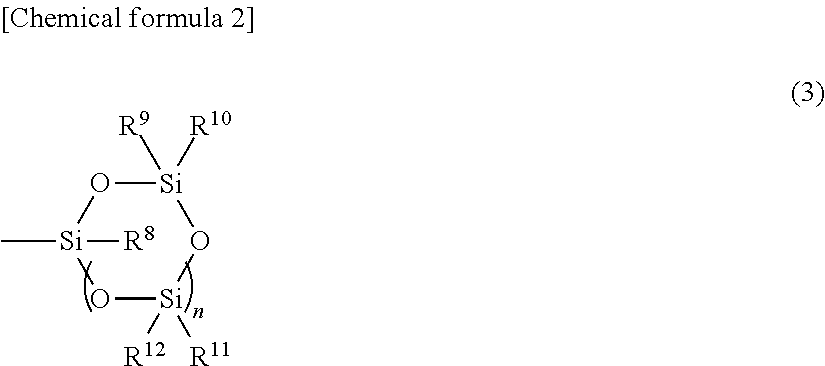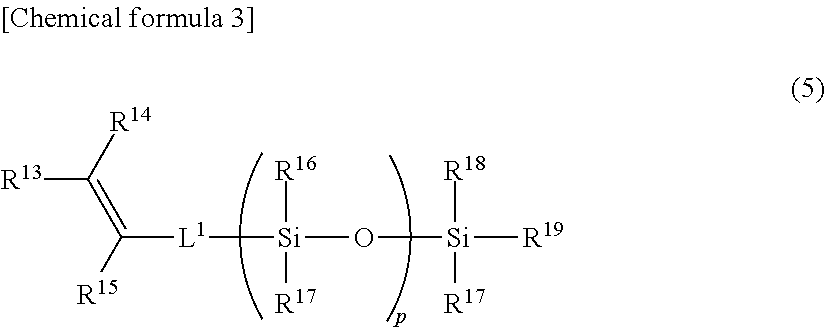Ring-opening polymer of cyclopentene and method of production of same
a technology of cyclopentin and cyclopentin, which is applied in the direction of transportation and packaging, tyre parts, special tyres, etc., can solve the problems of poor heat generation property, inability to use various rubbers, and poor rubber properties, and achieve excellent processability and a rubber composition. , the effect of excellent rubber properties
- Summary
- Abstract
- Description
- Claims
- Application Information
AI Technical Summary
Benefits of technology
Problems solved by technology
Method used
Image
Examples
reference example 1
Preparation of diisobutyl aluminum mono(n-hexoxide) / toluene solution (2.5 wt %)
[0119]Under the nitrogen atmosphere, 88 parts of toluene and 7.8 parts of 25.4 wt % of triisobutyl aluminum / n-hexane solution (made by TOSOH FINECHEM CORPORATION) were added to a glass vessel containing a stir bar. After cooling to −45° C., 1.02 parts of n-hexanol (the same molar amount as triisobutyl aluminum) were slowly added dropwise under vigorous stirring. After that, the mixture was kept under stirring until it reached the room temperature to prepare diisobutyl aluminum mono(n-hexoxide) / toluene solution (2.5 wt %).
reference example 2
Preparation of diisobutyl aluminum mono(n-butoxide) / toluene solution (2.5 wt %)
[0120]Except for using 0.74 part of n-butanol (the same molar amount as triisobutyl aluminum) instead of 1.02 parts of n-hexanol (the same molar amount as triisobutyl aluminum), the same procedure was followed as in Reference example 1 to prepare diisobutyl aluminum mono(n-butoxide) / toluene solution (2.5 wt %).
example 1
[0121]Under the nitrogen atmosphere, 8.7 parts of 1.0 wt % of WCl6 / toluene solution and 4.3 parts of 2.5 wt % of diisobutyl aluminum mono(n-hexoxide) / toluene solution prepared in Reference example 1 were added to a glass vessel containing a stir bar and stirred for 15 minutes to obtain a catalyst solution. Under the nitrogen atmosphere, 150 parts of cyclopentene and 0.22 part of allyl triethoxy silane were added to a pressure resistant glass reaction vessel equipped with a stirrer. 13 parts of the catalyst solution prepared above were added thereto and the polymerization reaction was allowed to occur for 6 hours at 25° C. After the polymerization reaction for 6 hours, an excess amount of isopropanol was added to the pressure resistant glass reaction vessel to terminate the reaction. The solution inside the pressure resistant glass reaction vessel was then poured over large excessive amount of isopropanol containing 2,6-di-t-butyl-p-cresol (BHT). Subsequently, precipitated polymer wa...
PUM
| Property | Measurement | Unit |
|---|---|---|
| Fraction | aaaaa | aaaaa |
| Fraction | aaaaa | aaaaa |
| Molecular weight | aaaaa | aaaaa |
Abstract
Description
Claims
Application Information
 Login to View More
Login to View More - R&D
- Intellectual Property
- Life Sciences
- Materials
- Tech Scout
- Unparalleled Data Quality
- Higher Quality Content
- 60% Fewer Hallucinations
Browse by: Latest US Patents, China's latest patents, Technical Efficacy Thesaurus, Application Domain, Technology Topic, Popular Technical Reports.
© 2025 PatSnap. All rights reserved.Legal|Privacy policy|Modern Slavery Act Transparency Statement|Sitemap|About US| Contact US: help@patsnap.com



